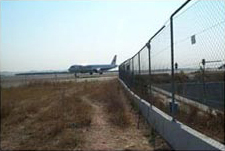
Frost and Sullivan Finds US Airport Perimeter Security Market in Decline
 The U.S. airport perimeter security market may have reached its saturation point. Most fence upgrades for perimeter control are small opportunities handled by local vendors. Security enhancements are the driving factor that will continue to open prospects into this niche market, although these are mainly implemented in larger airports.
The U.S. airport perimeter security market may have reached its saturation point. Most fence upgrades for perimeter control are small opportunities handled by local vendors. Security enhancements are the driving factor that will continue to open prospects into this niche market, although these are mainly implemented in larger airports.
New analysis from Frost & Sullivan, U.S. Airport Perimeter Security, finds that the Federal Aviation Administration (FAA) invested an estimated $58 million in grants toward the market through its Airport Improvement Programs (AIP) in 2012. Future funding toward airport perimeter security, though, is expected to decline through 2017. Additionally, the perimeter control segment, consisting of fences and gates, is at an oversupplied point.
The physical size and location of airports make it difficult to provide adequate and effective security. Companies have failed to succeed in offering airports an effective, reliable, and cost-effective integrated security system that is suitable to airports of all sizes. Most tailored security systems designed for large airports still experience vulnerability gaps due to factors caused by human error.
“Some airports, such as John F. Kennedy (JFK) International Airport in New York, are on a waterfront and easy to approach with a small boat,” said Frost & Sullivan Aerospace & Defense Senior Industry Analyst, John Hernandez. “Post 9/11, new security measures were put into effect to protect these airports. Despite these measures, in August 2012, a man whose Jet Ski stopped working decided to swim ashore to JFK Airport, climbed an eight-foot barbed-wire perimeter fence and walked through the airport's $100 million perimeter intrusion detection system and across two runways undetected until he reached an airline terminal.”
Airport perimeter security technologies are only as good as the people who manage and operate them. Continued mishaps may prompt the advent of automated, unmanned systems as a solution to eliminate human error.
“Terrorism and unlawful intrusion are the primary causes driving the demand for effective perimeter security equipment,” said Hernandez. “According to reports from the government, the Transportation Security Administration (TSA) had not conducted vulnerability assessments for 87 percent of the close to 450 U.S. airports regulated by TSA for security in 2009. The lack of these assessments creates uncertainty around the physical security effectiveness of those airports."
To view the video on Frost & Sullivan’s U.S. Airport Perimeter Security analysis, click here.